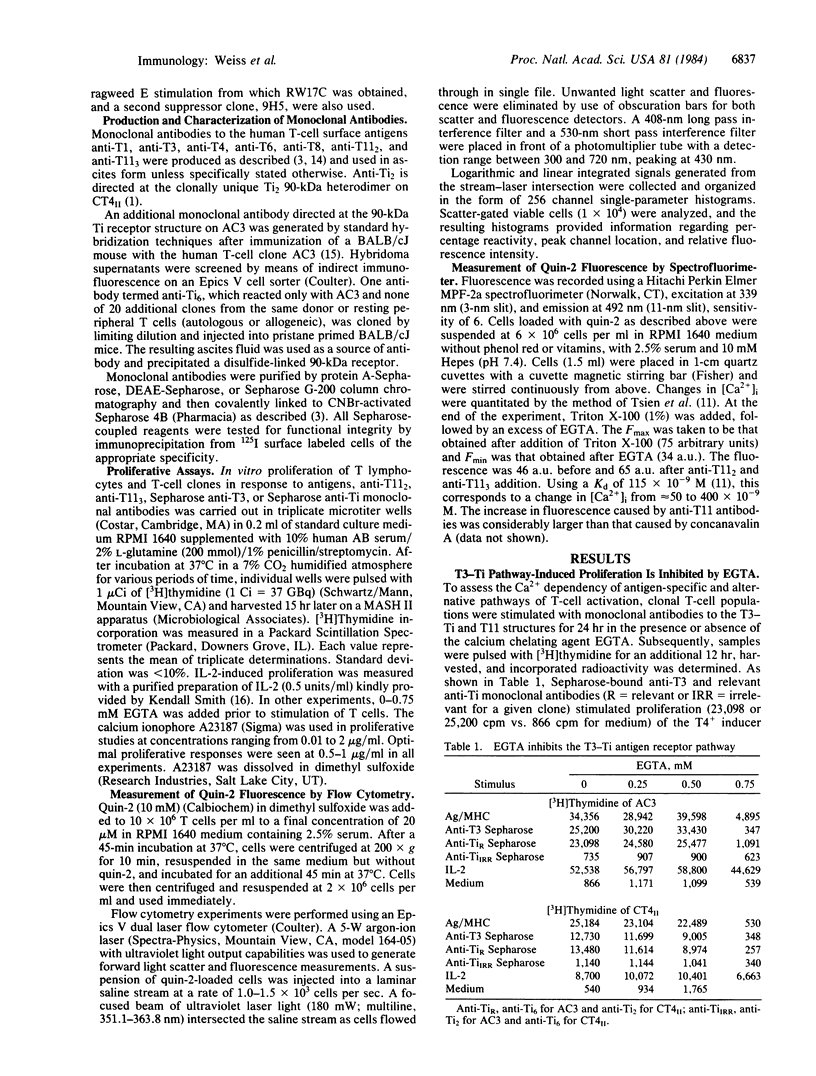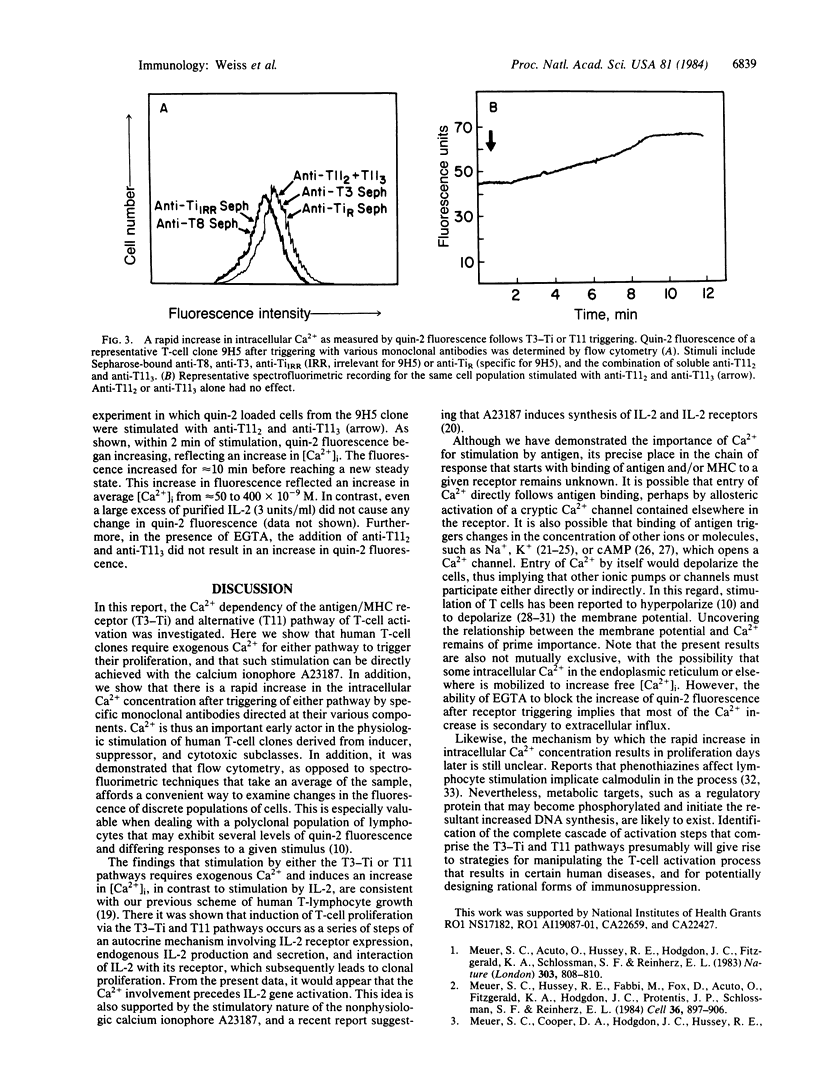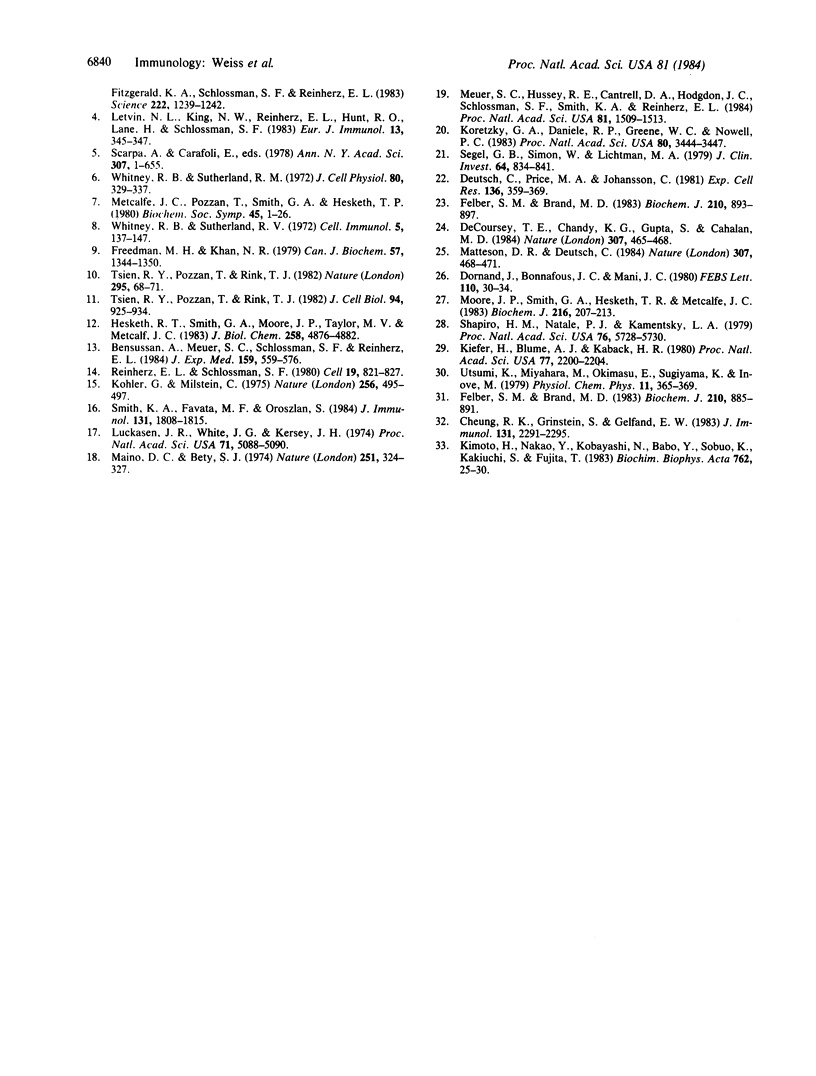Abstract
Human T lymphocytes are activated by two lineage-specific surface components: the antigen/major histocompatibility complex receptor (T3-Ti) and the unrelated T11 molecule. Interaction of either of these with their respective ligands leads to T-cell proliferation via an interleukin 2(IL-2) dependent autocrine mechanism. To begin to characterize the molecular details of the activation process, the role of Ca2+ was examined using human T-cell clones and monoclonal antibodies directed against their surface components. Here, we show that within minutes of triggering either the T3-Ti or T11 molecule, there is a large increase in intracellular Ca2+ concentration, as measured by quin-2 fluorescence. This is essential for induction of T-cell proliferation in inducer, suppressor, and cytotoxic clones and therefore presumably is required at an early step in the autocrine growth pathway. Thus, chelating exogenous Ca2+ with EGTA specifically inhibits proliferation triggered by anti-T3-Ti or anti-T11 monoclonal antibodies, but it does not affect triggering by exogenous IL-2. In addition, the Ca2+ ionophore A23187 can, by itself, initiate clonal proliferation.
Full text
PDF




Selected References
These references are in PubMed. This may not be the complete list of references from this article.
- Bensussan A., Meuer S. C., Schlossman S. F., Reinherz E. L. Delineation of an immunoregulatory amplifier population recognizing autologous Ia molecules. Analysis with human T cell clones. J Exp Med. 1984 Feb 1;159(2):559–576. doi: 10.1084/jem.159.2.559. [DOI] [PMC free article] [PubMed] [Google Scholar]
- Cheung R. K., Grinstein S., Gelfand E. W. Permissive role of calcium in the inhibition of T cell mitogenesis by calmodulin antagonists. J Immunol. 1983 Nov;131(5):2291–2295. [PubMed] [Google Scholar]
- DeCoursey T. E., Chandy K. G., Gupta S., Cahalan M. D. Voltage-gated K+ channels in human T lymphocytes: a role in mitogenesis? Nature. 1984 Feb 2;307(5950):465–468. doi: 10.1038/307465a0. [DOI] [PubMed] [Google Scholar]
- Deutsch C., Price M. A., Johansson C. A sodium requirement for mitogen-induced proliferation in human peripheral blood lymphocytes. Exp Cell Res. 1981 Dec;136(2):359–369. doi: 10.1016/0014-4827(81)90015-x. [DOI] [PubMed] [Google Scholar]
- Dornand J., Bonnafous J. C., Mani J. C. 5'-nucleotidase--adenylate cyclase relationships in mouse thymocytes. A re-evaluation of the effects of concanavalin A on cyclic AMP levels. FEBS Lett. 1980 Jan 28;110(1):30–34. doi: 10.1016/0014-5793(80)80015-9. [DOI] [PubMed] [Google Scholar]
- Felber S. M., Brand M. D. Concanavalin A causes an increase in sodium permeability and intracellular sodium content of pig lymphocytes. Biochem J. 1983 Mar 15;210(3):893–897. doi: 10.1042/bj2100893. [DOI] [PMC free article] [PubMed] [Google Scholar]
- Felber S. M., Brand M. D. Early plasma-membrane-potential changes during stimulation of lymphocytes by concanavalin A. Biochem J. 1983 Mar 15;210(3):885–891. doi: 10.1042/bj2100885. [DOI] [PMC free article] [PubMed] [Google Scholar]
- Freedman M. H., Khan N. R. A rapid technique for measuring calcium uptake in mitogen-induced T and B lymphocytes. Can J Biochem. 1979 Dec;57(12):1344–1350. doi: 10.1139/o79-179. [DOI] [PubMed] [Google Scholar]
- Hesketh T. R., Smith G. A., Moore J. P., Taylor M. V., Metcalfe J. C. Free cytoplasmic calcium concentration and the mitogenic stimulation of lymphocytes. J Biol Chem. 1983 Apr 25;258(8):4876–4882. [PubMed] [Google Scholar]
- Kiefer H., Blume A. J., Kaback H. R. Membrane potential changes during mitogenic stimulation of mouse spleen lymphocytes. Proc Natl Acad Sci U S A. 1980 Apr;77(4):2200–2204. doi: 10.1073/pnas.77.4.2200. [DOI] [PMC free article] [PubMed] [Google Scholar]
- Kimoto H., Nakao Y., Kobayashi N., Baba Y., Sobue K., Kakiuchi S., Fujita T. Heterogeneous pathways of Ca2+ metabolism in the triggering of the proliferative process in rat thymocytes. Biochim Biophys Acta. 1983 Feb 16;762(1):25–30. doi: 10.1016/0167-4889(83)90112-x. [DOI] [PubMed] [Google Scholar]
- Koretzky G. A., Daniele R. P., Greene W. C., Nowell P. C. Evidence for an interleukin-independent pathway for human lymphocyte activation. Proc Natl Acad Sci U S A. 1983 Jun;80(11):3444–3447. doi: 10.1073/pnas.80.11.3444. [DOI] [PMC free article] [PubMed] [Google Scholar]
- Köhler G., Milstein C. Continuous cultures of fused cells secreting antibody of predefined specificity. Nature. 1975 Aug 7;256(5517):495–497. doi: 10.1038/256495a0. [DOI] [PubMed] [Google Scholar]
- Letvin N. L., King N. W., Reinherz E. L., Hunt R. D., Lane H., Schlossman S. F. T lymphocyte surface antigens in primates. Eur J Immunol. 1983 Apr;13(4):345–347. doi: 10.1002/eji.1830130414. [DOI] [PubMed] [Google Scholar]
- Luckasen J. R., White J. G., Kersey J. H. Mitogenic properties of a calcium ionophore, A23187. Proc Natl Acad Sci U S A. 1974 Dec;71(12):5088–5090. doi: 10.1073/pnas.71.12.5088. [DOI] [PMC free article] [PubMed] [Google Scholar]
- Maino V. C., Green N. M., Crumpton M. J. The role of calcium ions in initiating transformation of lymphocytes. Nature. 1974 Sep 27;251(5473):324–327. doi: 10.1038/251324b0. [DOI] [PubMed] [Google Scholar]
- Matteson D. R., Deutsch C. K channels in T lymphocytes: a patch clamp study using monoclonal antibody adhesion. Nature. 1984 Feb 2;307(5950):468–471. doi: 10.1038/307468a0. [DOI] [PubMed] [Google Scholar]
- Metcalfe J. C., Pozzan T., Smith G. A., Hesketh T. R. A calcium hypothesis for the control of cell growth. Biochem Soc Symp. 1980;45:1–26. [PubMed] [Google Scholar]
- Meuer S. C., Acuto O., Hussey R. E., Hodgdon J. C., Fitzgerald K. A., Schlossman S. F., Reinherz E. L. Evidence for the T3-associated 90K heterodimer as the T-cell antigen receptor. Nature. 1983 Jun 30;303(5920):808–810. doi: 10.1038/303808a0. [DOI] [PubMed] [Google Scholar]
- Meuer S. C., Cooper D. A., Hodgdon J. C., Hussey R. E., Fitzgerald K. A., Schlossman S. F., Reinherz E. L. Identification of the receptor for antigen and major histocompatibility complex on human inducer T lymphocytes. Science. 1983 Dec 16;222(4629):1239–1242. doi: 10.1126/science.6606228. [DOI] [PubMed] [Google Scholar]
- Meuer S. C., Hussey R. E., Cantrell D. A., Hodgdon J. C., Schlossman S. F., Smith K. A., Reinherz E. L. Triggering of the T3-Ti antigen-receptor complex results in clonal T-cell proliferation through an interleukin 2-dependent autocrine pathway. Proc Natl Acad Sci U S A. 1984 Mar;81(5):1509–1513. doi: 10.1073/pnas.81.5.1509. [DOI] [PMC free article] [PubMed] [Google Scholar]
- Meuer S. C., Hussey R. E., Fabbi M., Fox D., Acuto O., Fitzgerald K. A., Hodgdon J. C., Protentis J. P., Schlossman S. F., Reinherz E. L. An alternative pathway of T-cell activation: a functional role for the 50 kd T11 sheep erythrocyte receptor protein. Cell. 1984 Apr;36(4):897–906. doi: 10.1016/0092-8674(84)90039-4. [DOI] [PubMed] [Google Scholar]
- Moore J. P., Smith G. A., Hesketh T. R., Metcalfe J. C. Large effects of preparative techniques on lymphocyte cyclic AMP content. Biochem J. 1983 Oct 15;216(1):207–213. doi: 10.1042/bj2160207. [DOI] [PMC free article] [PubMed] [Google Scholar]
- Reinherz E. L., Schlossman S. F. The differentiation and function of human T lymphocytes. Cell. 1980 Apr;19(4):821–827. doi: 10.1016/0092-8674(80)90072-0. [DOI] [PubMed] [Google Scholar]
- Segel G. B., Simon W., Lichtman M. A. Regulation of sodium and potassium transport in phytohemagglutinin-stimulated human blood lymphocytes. J Clin Invest. 1979 Sep;64(3):834–841. doi: 10.1172/JCI109531. [DOI] [PMC free article] [PubMed] [Google Scholar]
- Shapiro H. M., Natale P. J., Kamentsky L. A. Estimation of membrane potentials of individual lymphocytes by flow cytometry. Proc Natl Acad Sci U S A. 1979 Nov;76(11):5728–5730. doi: 10.1073/pnas.76.11.5728. [DOI] [PMC free article] [PubMed] [Google Scholar]
- Smith K. A., Favata M. F., Oroszlan S. Production and characterization of monoclonal antibodies to human interleukin 2: strategy and tactics. J Immunol. 1983 Oct;131(4):1808–1815. [PubMed] [Google Scholar]
- Tsien R. Y., Pozzan T., Rink T. J. T-cell mitogens cause early changes in cytoplasmic free Ca2+ and membrane potential in lymphocytes. Nature. 1982 Jan 7;295(5844):68–71. doi: 10.1038/295068a0. [DOI] [PubMed] [Google Scholar]
- Utsumi K., Miyahara M., Okimasu E., Sugiyama K., Inoue M. Modulation of thymocyte membrane potential by concanavalin A. Physiol Chem Phys. 1979;11(4):365–369. [PubMed] [Google Scholar]
- Whitney R. B., Sutherland R. M. Enhanced uptake of calcium by transforming lymphocytes. Cell Immunol. 1972 Sep;5(1):137–147. doi: 10.1016/0008-8749(72)90091-3. [DOI] [PubMed] [Google Scholar]
- Whitney R. B., Sutherland R. M. Requirement for calcium ions in lymphocyte transformation stimulated by phytohemagglutinin. J Cell Physiol. 1972 Dec;80(3):329–337. doi: 10.1002/jcp.1040800303. [DOI] [PubMed] [Google Scholar]


